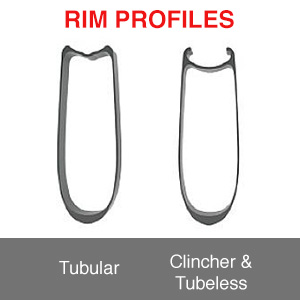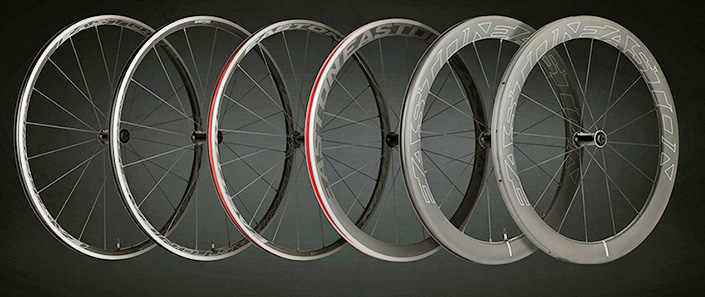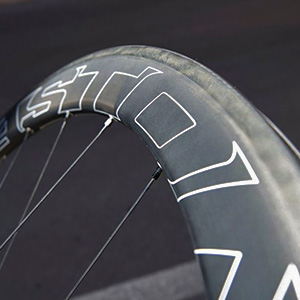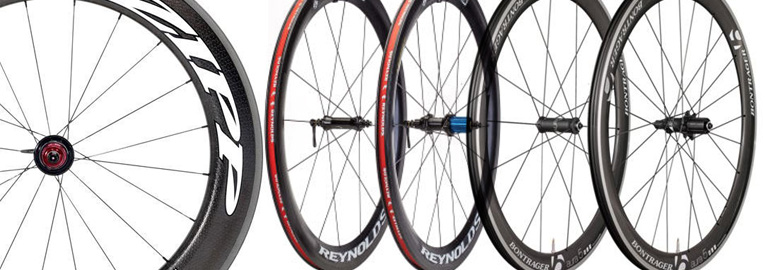
Upgrading to aerodynamic wheels is the most effective, and definitely the most popular, way to improve the performance of your bike. You're not just reducing the weight of your bike, but you're also benefiting from a lower rolling resistance and better aerodynamics. But it's not all champagne and cheese... There's a lot to consider when you upgrade to aerodynamic wheels; from rim depth through to tubeless compatibility. So before you walk into your Local Bike Shop and point your wallet at those wheels, read on and make a smart purchase.
BACKGROUND INFORMATION

Before we get into the details you must learn some basics about aerodynamic wheels first. If you're clued up, skip this part. Wheels come as 'clincher' or 'tubular' in design. Clincher rims are only suited to tires that clinch onto the rim - the type on 90% of road bikes. Tubular rims are strictly for tubular tires, a style of tire that is totally sealed, with no tube required. These tires are glued onto the rim with a semi-permanent rim cement.
Aerodynamic rims also come in various 'depths' in reference to how tall the rim profile is. When you say "Those wheels are 80mm deep", you're saying that the rim profile is 80mm tall; from where the spokes go in to where the tire goes on. Deeper wheels weigh more, but offer huge aerodynamic advantages. Low profile, or shallow wheels, offer more acceleration and less weight. A midway point offers the best of both worlds.
Tubeless tires are strictly for clincher rims, and allow you to ride a tubeless setup with a self-sealing liquid. This means less punctures and more air pressure options. This is coming more to the fore so definitely consider it.
Now let's get into these new aero wheels!

1. INTENDED USAGE
When you look at buying an aero wheelset it is important to consider how you'll be using them. If you live in a hilly area with lots of climbs you'll want to look at a rim profile suited to this. If you have very deep rims, around 60-80mm deep, you'll be dragging excess material uphill as well as riding wheels that don't offer a great deal of benefit.
If you live in a very windy region, again you'll be looking at a midpoint in rim depth, around the 40-50mm deep range. This means you'll be less affected by strong crosswinds when riding, unlike your pals on 80mm deep wind catchers.
If you live in an area with normal winds, you can ride a rim as deep as you want. A set of 80mm deep hoops will really keep you rolling!
2. MATERIALS
If you don't like carbon fiber, you'd better be a master of home crafts. All aerodynamic wheels are carbon fiber (mainstream market). Due to the ease of manipulation and structural strength of carbon fiber, it's the chosen material. It's easy to achieve the aerodynamic properties that are required when using such an advanced material. Be aware of the manner in which you treat your wheels though - carbon fiber is strong at withstanding intended stresses, such as load and pull - However, carbon is quite weak in terms of blunt impacts. The kind you'd encounter in a crash.
Lastly, if you intend swapping between alloy rims and carbon rims, you'll also need to change your brake pads. You CANNOT use normal brake pads on carbon rims, as they will destroy the rim and also offer questionable performance. Using carbon specific pads on an alloy rim is harmless, despite a small drop in braking strength.
DID YOU KNOW? Aero wheels can be completely made from carbon or, alternatively, have an alloy brake surface and spoke bed with a carbon layer "glued" on to provide the rim depth. If you have a full carbon wheel you must follow the advice above concerning specific brake pads. Also note that even with these pads, the braking performance of a carbon surface may not be as good as a wheel with an alloy surface. Talk to your local bike shop about which option is best for you.
3. TUBULAR, CLINCHER OR TUBELESS

image: probikeswap.com
Tubular wheels are best kept for racing. The benefit of a tubular rim and tire is the ability to achieve far lower and higher pressures than any other system. You'll also be riding a tire with a larger contact patch, with grip all the way to your rim edges (not just on top) - a result of the tubular's ability to deform and remain flexible due to a high TPI (Threads Per Inch). The downside of this system is that you replace the tire, not the tube. If you get a flat while riding you'll need to be either be lucky enough to have puncture sealant in a pressurized can, or enough money for a taxi home.
Clincher wheels are the most appropriate for all purpose use. There are plenty of high quality tires on offer which allow you to get the most out of your wheelset upgrade. Clinchers are the 'normal' tires you'd see on your bike and allow you to change a tube in the event of a flat.
Tubeless rims are capable of hosting normal as well as tubeless tires. Tubeless tires do not use a tube inside of them (duh!), but instead rely on a completely airtight seal with the rim. In addition to this, a small amount of sealant fluid can be injected into the tire. Tubeless rims and tires mean less flats and a larger spectrum of tire pressures on offer.
4. BRAND COMPATIBILITY
It might seem like a straightforward swap, but it has been known for some wheels to not have good compatibility with certain bikes. This is quite rare, but is still worth knowing! Check which groupset your bike runs. You'll need to ensure your new wheels have the correct freewheel body - the thing that goes 'Zzzzzzzzz' when you stop pedaling. This freewheel comes in different configurations for all the different groupset brands. Shimano, Campagnolo and SRAM all have their own freewheel bodies - make sure your wheels come with the correct one to match your groupset.
Another point to consider is rim width. Some brands offer slightly wider rim profiles, meaning it's a tight squeeze to get the wheel in between the brake pads, let alone the frame. Just mention it to your Local Bike Shop and let them sort it out. It's not really a common problem, but it can ruin your day.
5. COST
The big question you've been avoiding all along: "How much are they?" Well, a wheelset upgrade can cost anywhere between $400 and $4,000 in price. So the question goes back to you... "How much do you want to spend?"
The best way to go about purchasing wheels with a gradual price increase is to choose one brand of wheelset. Find a reliable and popular brand and ensure your local bike shop has a good track record with them. This means you'll always have access to spares in the future, as well as possible warranty procedures.
When you look at one brand of wheels, you'll be able to see a visual and technological improvement in the wheels as you take one step up. You might find one aerodynamic wheelset is only $900, only to realize the wheelset isn't actually carbon fiber (instead, it's an alloy rim with a carbon fairing around the rim face). Then you take one step up, and find yourself looking at a $1,500 wheelset with full carbon rims but the exact same hubs. The difference between the two is very obvious, as opposed to if you were comparing five major brands, and trying to figure out comparative pricing.
It's not as hard as it sounds, but the first step in upgrading your wheels to something more aerodynamic is to obtain some quality advice. Pop in to your local bike shop and enquire about aero wheels - you might even be lucky enough to score a free ride on a demo set. You'll know when the wheels suit your needs, especially if you keep the above points in mind. If you do invest in some very expensive wheels, keep them for special rides or races. This will lengthen their lifespan and reduce the chance of damage.
Now all you need is a one piece skinsuit!




